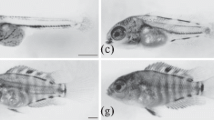Summary
Histological changes in the pituitary TSH cells and in the thyroid gland of flounder (Paralichthys olivaceus) larvae during spontaneous or artificially induced metamorphosis were studied. Activity of the immunoreactive TSH cells (IrTSH cells) gradually increased during premetamorphosis, reaching the highest level in prometamorphic larvae, and the cells were degranulated in metamorphic climax. The IrTSH cells were most inactive at the post-climax stage. The thyroid gland was morphologically the most active in metamorphic climax when the degranulation occurred in the pituitary IrTSH cells, and appeared inactive at post-climax. A few weeks after metamorphosis, both the IrTSH cells and the thyroid gland appeared to be activated again in the benthic, juvenile flounder. Administration of thyroxine or thiourea revealed negative feedback regulation of the pituitary-thyroid axis in flounder larvae. These results indicate that activation of the pituitary-thyroid axis induces metamorphosis in the flounder.
Similar content being viewed by others
References
Baker BL (1974) Functional cytology of the hypophysial pars distalis and pars intermedia. In: Knobil E, Sawyer WH (eds) Handbook of physiology, section 7, vol. 4. The pituitary gland and its neuroendocrine control, part 1. American Physiological Society, Washington DC, pp 45–80
Baker BL, Yu YY (1971) The thyrotropic cell of the rat hypophysis as studied with peroxidase-labeled antibody. Am J Anat 131:55–72
Ball JN (1981) Hypothalamic control of the pars distalis in fishes, amphibians, and reptiles. Gen Comp Endocrinol 44:135–170
Ball JN, Baker BI (1969) The pituitary gland: anatomy and histophysiology. In: Hoar WS, Randall DJ (ededs) Fish physiology, vol. 2. The endocrine system. Academic Press, New York London, pp 1–110
D'Angelo SA (1958) Role of the hypothalamus in pituitary-thyroid interplay. J Endocrinol 17:286–299
Dodd MHI, Dodd JM (1976) The biology of metamorphosis. In: Lofts B (ed) Physiology of the amphibia vol. 3. Academic press, New York, pp 467–599
Eales JG (1979) Thyroid functions in cyclostomes and fishes. In: Barrington EJW (ed) Hormones and evolution vol. 1. Academic press, New York San Francisco London, pp 341–436
Etkin W (1963) The metamorphosis activating system of the frog. Science 139:810–814
Folmar LC, Dickhoff WW (1980) The parr-smolt transformation (smoltification) and seawater adaptation in salmonids. Aquaculture 21:1–37
Inui Y, Miwa S (1985) Thyroid hormone induces metamorphosis of flounder larvae. Gen Comp Endocrinol 60:450–454
Peter RE (1973) Neuroendocrinology of teleosts. Am Zool 13:743–755
Peter RE, McKeown BA (1975) Hypothalamic control of prolactin and thyrotropin secretion in teleosts, with special reference to recent studies on the goldfish. Gen Comp Endocrinol 25:153–165
Purves HD, Griesbach WE (1951a) The site of thyrotrophin and gonadotrophin production in the rat pituitary studied by McManus-Hotchkiss staining for glycoprotein. Endocrinology 49:244–264
Purves HD, Griesbach WE (1951b) The significance of the Gomori staining of the basophils of the rat pituitary. Endocrinology 49:652–662
Regard E, Taurog A, Nakashima T (1978) Plasma thyroxine and triiodothyronine levels in spontaneously metamorphosing Rana catesbeiana tadpoles and in adult anuran Amphibia. Endocrinology 102:674–684
Rosenkilde P (1979) The thyroid hormones in Amphibia. In: Barrington EJW (ed) Hormones and evolution vol. 1. Academic press, New York San Francisco London, pp 437–491
Sternberger LA, Hardy PH Jr, Cuculis JJ, Meyer HG (1970) The unlabeled antibody enzyme method of immunohistochemistry: preparation and properties of soluble antigen-antibody complex (horseradish peroxidase-antihorseradish peroxidase) and its use in identification of spirochetes. J Histochem Cytochem 18:315–333
Wedemeyer GA, Saunders RL, Clarke C (1980) Environmental factors affecting smoltification and early marine survival of anadromous salmonids. Mar Fish Rev 42:1–14
Author information
Authors and Affiliations
Rights and permissions
About this article
Cite this article
Miwa, S., Inui, Y. Histological changes in the pituitary-thyroid axis during spontaneous and artificially-induced metamorphosis of larvae of the flounder Paralichthys olivaceus . Cell Tissue Res. 249, 117–123 (1987). https://doi.org/10.1007/BF00215425
Accepted:
Issue Date:
DOI: https://doi.org/10.1007/BF00215425




